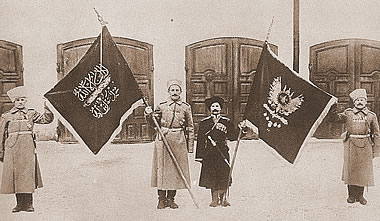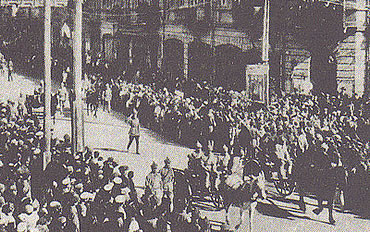The First Republic
Collapse of Transcaucasian Federation
 Russian troops holding captured Turkish flags at Erzerum, photo published in Britain in 1916
Russian troops holding captured Turkish flags at Erzerum, photo published in Britain in 1916
In February 1916, the Russian Army had taken the cities of Erzurum and Trebizond. However, Armenian hopes were buried as Russia started to retreat from the war, following the outbreak of the Russian Revolution.
The triumph of Bolsheviks in 1917 put an end to the Russian Empire. In winter 1918, the Armenian, Georgian and Moslem leaders of Transcaucasia decided to unite to convene the Transcaucasian Federation, which proclaimed the secession of Transcaucasia from Russia.
The Turks, rapturous over the Russian Revolution, welcomed it as almost a miracle. With the decline of the Russian military power, the Caucasus front collapsed, and the decaying Turkish power suddenly survived. To prevent the further destruction of the new Bolshevik State, Vladimir Lenin was forced to conclude the humiliating Treaty of Brest-Litovsk. The treaty had drastic consequences for the Armenians. The Turkish forces reoccupied the lands of the Western Armenia, earlier liberated by Russians.
In late May 1918, under the threat of a new Turkish offensive on the Caucasus, the Transcaucasian Federation collapsed after only 3 months of existence. In fact, the Federation was a still-born creature from the very beginning. Insuperable divergences existed between the Armenian, Georgian and Moslem deputations. The Georgians were oriented to Germany, and the Moslems to Turkey, whereas the Armenians, though loyal to the Entente, were supported by nobody.
On May 26 the independence of Georgia was declared. At the same time, the Moslems proclaimed a “Musavat Republic of Azerbaijan“. This new Turkish state, created in the historical lands of the eastern Armenia, immediately laid claims on the Armenian territories in Karabakh, Zangezur and Nakhichevan.
The independence of Armenia proclaimed
Left alone, Armenians faced the total annihilation as the 100,000 Turkish army crossed the pre-war Russian frontier, annexed the city of Kars and approached the Armenian capital Yerevan. After having depopulated the Western Armenia, the Turkish military were now about to destroy the rest of Armenia, and achieve their goal of eliminating the Armenian nation.
The Armenians raised an army of 40,000 men, including soldiers, officers, volunteers and mass levies. At first the Dashnak leaders wanted to evacuate the population and to surrender Yerevan, but the Military Council headed by Colonel Pirumian finally decided to do battle.
 General Moses Silikyan (Silikov), commander of Armenian troops in the battle of Sardarapat.The two armies met on May 28, 1918 near Sardarapat. The battle was crowned with an outstanding Armenian victory. Some 30 thousand Turkish soldiers were killed; the Turks were flung out. Vahib-Pasha, the defeated Turkish commander, termed the Armenian soldiers as “the best fighters in the world“. The Armenians also held defenses at Karaklis and at Abaran.
General Moses Silikyan (Silikov), commander of Armenian troops in the battle of Sardarapat.The two armies met on May 28, 1918 near Sardarapat. The battle was crowned with an outstanding Armenian victory. Some 30 thousand Turkish soldiers were killed; the Turks were flung out. Vahib-Pasha, the defeated Turkish commander, termed the Armenian soldiers as “the best fighters in the world“. The Armenians also held defenses at Karaklis and at Abaran.
On the same day of May 28, 1918 Armenia was proclaimed an independent republic. However, the embryo state was devastated, with a dislocated economy, dozens of thousands of refugees and the population starving. The danger of a new Turkish aggression was still imminent. Also, the country was soon involved in a territorial conflict with Georgia. Moreover, the situation in Karabakh was especially dangerous as the new Azerbaijani state made a series of ultimatums to the Armenian population.
In September, 1918 the Turkish troops invaded Baku and joined the Turkish-Azeri mobs in massacring some 30, 000 Armenians. Dozens of surrounding Armenian villages were completely destroyed.
The Wilsonian borders
 President Woodrow Wilson
President Woodrow Wilson
Meanwhile, the European powers found themselves unable to solve the Armenian Question. The unification of the Caucasian Armenia with the Turkish Armenia proclaimed by the Armenian government in 1919 turned out Utopian. After Armenia was officially recognized by the governments of Allies and by the United States, the US President Woodrow Wilson was invited to determine the borders of the future Armenian State. According to Wilson’s map, a new Armenia would include most of its historically belonging lands. The project would never come true.
Armenia falls to Bolsheviks
 Mustafa Kemal, Ataturk
Mustafa Kemal, Ataturk
Furthermore, Armenia would face the new territorial losses. Mustafa Kemal, the new Turkish opposition leader, was able to reach an agreement with the Bolshevik leaders of Russia. Enthusiastic with the idea of “exporting the revolution eastward”, Lenin and Stalin were prompt in starting an unprecedented financial and military aid to Kemal. At that time Armenia exploded into anarchy as the Armenian Bolsheviks rose in the cities of Nakhichevan, Alexandrople and Kars. The Soviet government hypocritically carnied secret negotiations with both Dashnak and Bolshevik leaders of Armenia.
In August 1920, the Treaty of Sèvres, signed by England, France and Turkey, bound Turkey to recognize the independence of Armenia and the Wilsonian boundaries. The new Armenian state was recognized by most of the countries, including the United States. However, after the triumph of Mustafa Kemal, the Turks, supported by the Bolshevik Russia, attacked the infant Armenian Republic again. The Armenian and Russian Bolsheviks played a fatal role in demoralizing the population and the Armenian army. The Bolshevik propaganda now started to call the Turks as “socialists” and “friends of Russians”, and finally totally disoriented the Armenian population. On the other hand, the victorious Russian XI Red Army, after successfully Sovietizing Baku, Azerbaijan, and Karabakh, approached Yerevan to “overthrow the Dashnaks”. The confused Armenian army retreated, surrendering Kars and the uyezd of Surmali. Following that retreat, the whole Armenian population of these regions was then pitilessly butchered by the Turks.
On November 29, 1920, Armenia was declared a Soviet state. However, the entire Zangezur region (called Syunik in Armenia) opposed to Sovietization. Garegin Njdeh, popular national hero, at the time commander of the southern corps of the Armenian army, led the defense against the Soviet troops. In December, 1920, Syunik was proclaimed a self-governing region.
In February, 1921, following an anti-Soviet rebellion in Yerevan, the ARF (Armenian Revolutionary Federation) seized power and controlled Yerevan for 42 days, but then, after the offensive of the Russian Red Army was forced to retreat to Syunik. On 26 April 1921, an independent Republic of the Mountainous Armenia was proclaimed, with Garegin Njdeh appointed Prime Minister and Minister of Defense. This new Armenian Republic existed just 3 months, capitulating after several massive offensive operations of the Red Army.










